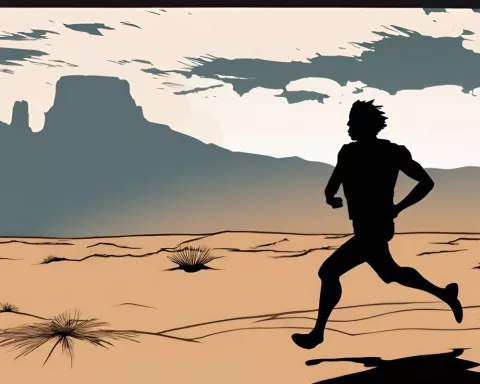Two female hikers were swept out to sea and trapped in a rocky gulley along the Otter Trail in South Africa. Their hiking companion called for help, and a daring rescue operation involving four NSRI rescue swimmers equipped with PFDs successfully brought them back to shore. The incident demonstrated the importance of being prepared and working together in a crisis, and underscored the indomitable human spirit and the strength of collaboration.
What happened during the Otter Trail rescue operation?
Two female hikers were swept out into the ocean and became trapped in a rocky gulley. Their hiking companion called for help, triggering a response from the NSRI Storms River rescue swimmers and SANParks rangers. A daring rescue operation involving four NSRI rescue swimmers equipped with PFDs successfully brought the hikers back to shore. The incident underscores the importance of being prepared and working together in a crisis.
Section 1: Disturbance in The Peaceful Environment
On a bright Friday, the serene beauty of the Otter trail, a much-loved hiking trail in [Tsitsikamma National Park](https://capetown.today/the-recent-rescue-of-14-hikers-from-the-tsitsikamma-hiking-trail-in-south-africa/) in South Africa, was disrupted by a critical situation. A pair of female hikers, part of a bigger group, were thrust into a life-threatening dilemma when they were carried out into the ocean at the Bloukrans River mouth. The resulting communal effort from the [NSRI Storms River](https://capetown.today/weathering-the-storm-a-story-of-united-strength-and-cooperation-on-south-african-shores/) unit and the Tsitsikamma Park officers was a powerful demonstration of community spirit and fast action.
What was once a picturesque setting along the Otter Trail swiftly became a scene of tension and drama as the two hikers were entrapped in the outgoing tide. Regardless of their inability to swim, they quickly resorted to using their backpacks as impromptu flotation tools, thereby averting an immediate catastrophe. They managed to reach a rocky gulley off the coast, but found themselves stuck, unable to climb the steep cliff or make their way through the water to the trail path. The rising tide added a sense of urgency to their situation.
Section 2: A Race Against Time
One of their hiking companions, realizing the danger, climbed a cliff and pursued an emergency path to get a mobile signal. His call to the South African National Parks (SANParks) triggered an urgent response from the NSRI Storms River rescue swimmers. Concurrently, the duty crew at NSRI Oyster Bay was making ready to launch a rescue boat if necessary.
The ensuing rescue operation was a complex amalgamation of swift decision-making and skilled execution. The NSRI Oyster Bay’s shore controller, Charles Hutchins, initially considered the idea of swimming the pair out to sea, where they could be picked up by a rescue boat. But the arrival of the rescue team at the scene necessitated a reevaluation of the plan.
The rough terrain required the use of an all-wheel-drive vehicle, but it could only get them so far. The NSRI rescue swimmers, together with the SANPark rangers, proceeded on foot, making their way to the distressed hikers. Upon reaching them, the decision was made to swim them back to the shore as opposed to taking them further into the open sea.
Section 3: A Daring Rescue Operation
Four NSRI rescue swimmers, equipped with Personal Floatation Devices (PFDs), fearlessly took to the waters and swam towards the struggling pair. Each woman was secured into a PFD and, one by one, they were swum back to the shore, on the opposite side of the gulley. The rescue swimmers, with the assistance of the SANPark rangers, successfully brought the daring rescue operation to a close.
The intensity of the situation was underscored by the fact that just 25 minutes post-rescue, the rocks, where the hikers had been stranded, were completely covered by the high tide. During the course of the rescue operation, the wind, adding another layer of risk, picked up to approximately 30 knots.
Section 4: A Display of Resilience and Strength
In spite of the distressing ordeal, the pair of rescued hikers decided to press on with their expedition, encouraged by the support from their fellow hikers and the dry gear they had. Observing their fortitude, Hutchins deemed it safe for them to continue their journey.
The account of this incident underscores the indomitable human spirit and the strength of collaboration. The quick responses from the NSRI Storms River team and the Tsitsikamma Park rangers indeed transformed a potential tragedy into a victory of human bravery and grit.
Moreover, this rescue operation emphasizes the importance of being prepared and thinking quickly in a crisis. It also highlights the significance of the support infrastructure provided by the park authorities. This Otter trail rescue story is a powerful narrative of hope, courage, teamwork, and human spirit, recounting the timeless tale of survival against challenging circumstances.
What happened during the Otter Trail rescue operation?
Two female hikers were swept out into the ocean and became trapped in a rocky gulley. Their hiking companion called for help, triggering a response from the NSRI Storms River rescue swimmers and SANParks rangers. A daring rescue operation involving four NSRI rescue swimmers equipped with PFDs successfully brought the hikers back to shore. The incident underscores the importance of being prepared and working together in a crisis.
What was the rescue operation like?
The rescue operation was a complex amalgamation of swift decision-making and skilled execution. The NSRI rescue swimmers, together with the SANPark rangers, proceeded on foot, making their way to the distressed hikers. Four NSRI rescue swimmers, equipped with Personal Floatation Devices (PFDs), fearlessly took to the waters and swam towards the struggling pair. Each woman was secured into a PFD and, one by one, they were swum back to the shore, on the opposite side of the gulley.
How long did the rescue operation take?
The rescue operation took approximately 25 minutes, and just 25 minutes post-rescue, the rocks, where the hikers had been stranded, were completely covered by the high tide.
What was the importance of being prepared and thinking quickly in a crisis?
The Otter Trail rescue operation emphasizes the importance of being prepared and thinking quickly in a crisis. The hikers’ ability to use their backpacks as impromptu flotation tools averted an immediate catastrophe. The quick responses from the NSRI Storms River team and the Tsitsikamma Park rangers transformed a potential tragedy into a victory of human bravery and grit.
What did the rescue operation highlight?
The importance of the support infrastructure provided by the park authorities was highlighted in the Otter Trail rescue operation. The quick response from the NSRI Storms River team and the Tsitsikamma Park rangers demonstrated the significance of collaboration and teamwork.
What does the Otter Trail rescue story tell us?
The Otter Trail rescue story is a powerful narrative of hope, courage, teamwork, and human spirit, recounting the timeless tale of survival against challenging circumstances. It underscores the indomitable human spirit and the strength of collaboration, and emphasizes the importance of being prepared and working together in a crisis.












